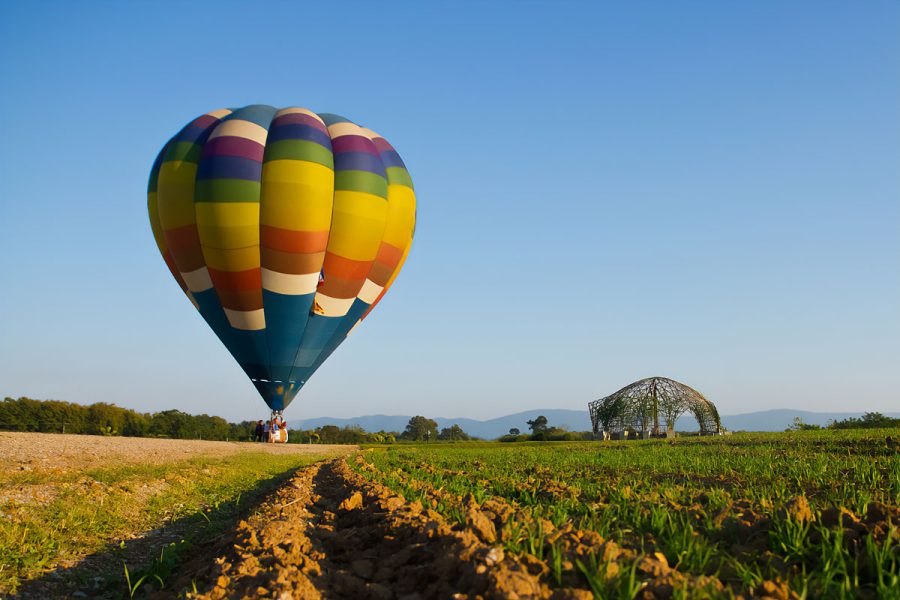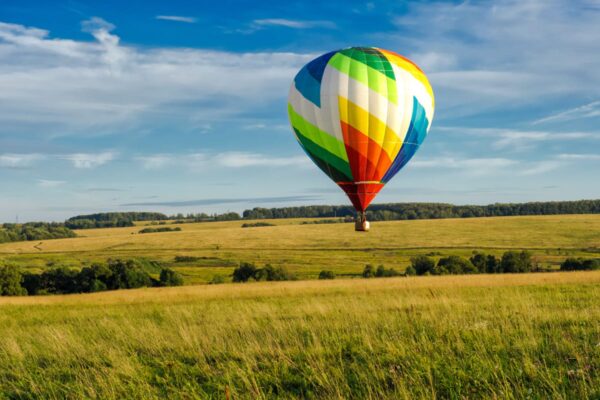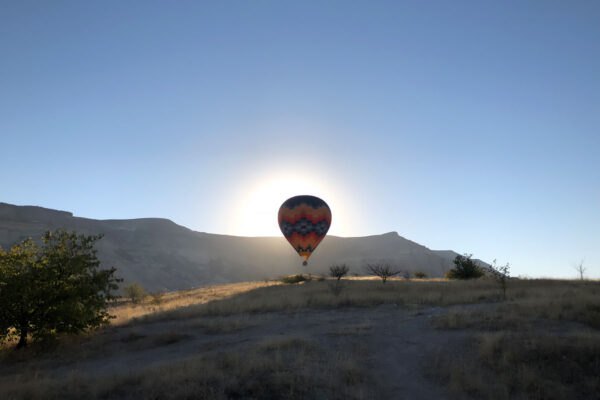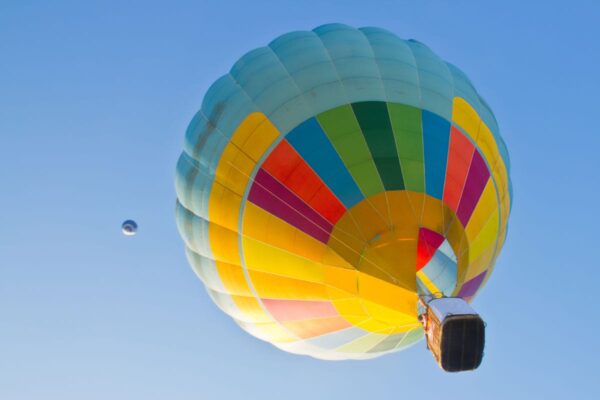Hot air balloon flight is one of the most magical experiences one can have. Floating above the landscape in silence, interrupted only by the sound of burners, evokes feelings that are hard to describe. However, planning such an adventure requires careful consideration of many factors that affect the safety and quality of the experience.
Choosing the right time for a hot air balloon flight is not accidental. Weather conditions, time of day, and season play a key role in the success of the entire endeavor. Professional balloon pilots carefully analyze weather forecasts, wind strength, and visibility before each flight. Proper scheduling guarantees not only a safe journey but also unforgettable views from a bird’s-eye perspective.
The best times of day for hot air balloon flights
The time of day is fundamentally important for the quality and safety of a hot air balloon flight. The atmosphere behaves differently throughout the day, directly affecting flying conditions. Professional pilots choose specific hours for good reason—air stability and wind speed vary significantly between morning and evening.
The most favorable conditions occur within certain time windows. Air temperature, humidity, and atmospheric thermal activity create an ideal environment for a safe balloon trip. Understanding these natural rhythms helps in selecting the optimal flight time.
Flights at sunrise
The early morning hours just after sunrise are considered the best time for a hot air balloon flight. The air is most stable then, and winds reach minimal speeds. The nighttime cooling keeps the atmosphere calm and predictable.
The temperature near the ground is at its lowest, which increases the difference between the hot air inside the balloon and the surrounding air. A greater temperature difference means better lift and easier control of the balloon. Pilots can more precisely manage altitude and direction.
The views at dawn have a unique character. The soft light of the rising sun paints the landscape in golden hues. Mists rising over valleys and lakes create a mystical atmosphere that cannot be experienced at other times of day.
Optimal hours for morning flights:
- Summer: 5:00 AM–7:00 AM
- Spring and autumn: 6:00 AM–8:00 AM
- Winter: 7:00 AM–9:00 AM
Preparations for morning flights begin very early. The crew must arrive at the launch site before sunrise to prepare equipment and conduct safety checks. Passengers should be ready to wake up early, but the reward of spectacular views certainly makes up for any inconvenience.
Flights before sunset
Evening flights starting 2–3 hours before sunset are a second optimal option. After heating throughout the day, the air begins to stabilize and winds weaken. Although conditions are not as ideal as in the morning, they still provide safe and comfortable flights.
The atmospheric temperature evens out after intense daytime sunlight. Thermals that can cause turbulence midday gradually disappear. Pilots use this natural atmospheric cycle to ensure a smooth journey.
Sunsets observed from a balloon basket are among the most romantic experiences. The sky takes on intense colors ranging from golden to orange to deep purple. The landscape below the balloon changes dramatically depending on the angle of the sunlight.
Evening flights have an additional advantage – after landing, you can participate in a traditional champagne toast. This ceremony, originating from the early days of ballooning, provides a beautiful conclusion to an extraordinary adventure. The warm light of the setting sun creates the perfect atmosphere for celebration.
Ideal Weather Conditions for a Safe Balloon Flight
Meteorological conditions are the most important factor determining the possibility of conducting a balloon flight. Passenger safety depends on a thorough analysis of the weather forecast and current atmospheric observations. Professional pilots monitor many weather parameters before making a decision to fly.
Atmospheric stability affects both comfort and safety during the journey. Sudden changes in pressure, temperature, and humidity can create hazardous flying conditions. Experienced pilots can read subtle weather signals and make the right decision to proceed with or cancel the flight.
Wind Speed and Direction
Wind is a key element influencing balloon flight safety. The maximum allowable wind speed at ground level is 5 meters per second. Exceeding this value can complicate safe takeoff and landing of the balloon.
The wind direction must be stable and predictable. Sudden changes in wind direction, known as windshear, can cause dangerous situations during flight. Pilots analyze wind forecasts at various altitudes to plan a safe travel route.
Wind at altitude differs significantly from wind at ground level. Balloons operate at heights ranging from 150 to 1000 meters, where wind speed and direction can be completely different. Experienced pilots use these differences for navigation and flight path control.
Wind measurements are performed using specialized instruments. Anemometers, sounding balloons, and meteorological systems provide accurate data about atmospheric conditions. Modern technology allows precise prediction of weather changes.
Visibility and Cloud Cover
Good visibility is essential for safe balloon piloting. The minimum required horizontal visibility is 5 kilometers. Fog, rain, or heavy snowfall can completely prevent balloon flights.
Cloud cover affects thermal conditions and visibility. Dense clouds can block solar radiation, impacting atmospheric stability. Thunderstorm clouds are an absolute contraindication for balloon flights due to dangerous air currents.
The cloud base height must provide a safe margin for balloon flight. The minimum cloud height is 300 meters above ground level. A low cloud base limits maneuvering options and may hinder safe landing.
Optimal Weather Conditions:
- Wind speed: 0-5 m/s
- Visibility: minimum 5 km
- Cloud base: above 300 m
- No precipitation
- Stable atmospheric pressure
Meteorological systems provide detailed weather forecasts for aviation. Balloon pilots use professional weather services that take into account the specifics of low-altitude flights. Accurate forecasts allow for flight planning several days in advance.
Temperature and Atmospheric Stability
Air temperature affects the balloon’s performance and passenger comfort. The optimal temperature range for balloon flights is from -10°C to +30°C. Extreme temperatures can affect the gas properties inside the balloon as well as passenger safety.
The temperature gradient, or the change in temperature with altitude, determines atmospheric stability. A thermal inversion, when temperature increases with altitude, creates very stable conditions for balloon flights. Such situations most often occur early in the morning.
Thermal convection, caused by uneven heating of the earth’s surface, can cause turbulence. Strong thermals make controlling the balloon difficult and can be dangerous for passengers. Therefore, flights are avoided during peak sunlight hours.
Air humidity affects visibility and flight comfort. High humidity can lead to fog or low clouds. Dry air provides better visibility and more stable atmospheric conditions.
Choosing the Right Season for a Scenic Balloon Flight
Seasonality has a huge impact on balloon flight conditions and the quality of visual experiences. Each season offers unique landscape attractions but also comes with different meteorological challenges. Understanding seasonal weather changes helps in selecting the optimal flight date.
A temperate climate is characterized by distinct differences between seasons. Temperature, precipitation, and day length change cyclically, affecting the feasibility of balloon flights. Professional operators adjust flight schedules according to seasonal weather conditions.
Spring – Nature Awakening
Spring, especially April and May, is considered one of the best seasons for balloon flights. Air temperatures are moderate, and atmospheric conditions are relatively stable. Nature awakens, creating spectacular views from a bird’s-eye perspective.
Blooming fruit trees, yellow rapeseed fields, and fresh green meadows form a colorful landscape mosaic. Color contrasts are particularly vivid during springtime. Day length increases, providing more opportunities to plan flights at optimal times.
Spring winds can be variable but are generally milder than winter winds. Low-pressure systems move faster, resulting in more frequent weather changes. Pilots must carefully monitor forecasts and be prepared for flexible flight planning.
Advantages of Spring Flights:
- Moderate air temperature
- Spectacular colors of blooming nature
- Longer days and more opportunities for flights
- Clean air after the winter period
Early spring can be unpredictable in terms of weather. Sudden temperature changes, late frosts, and variable precipitation require a flexible approach to planning. However, the reward of beautiful views certainly makes up for these minor inconveniences.
Summer – long days and stable weather
The summer months offer the most stable weather conditions for balloon flights. High atmospheric pressure, characteristic of summer, provides calm and predictable flying conditions. Long days offer a wide time window for planning flights at optimal hours.
The summer landscape is characterized by lush greenery and ripening crops. Golden grain fields, green meadows, and blue lakes create a harmonious color composition. Visibility is usually very good, allowing you to admire distant panoramas.
However, summer also comes with certain challenges. High midday temperatures can cause strong thermal convection. Intense thermals make balloon control difficult and can be dangerous. Therefore, summer flights focus on early morning hours.
Summer storms pose the main threat to balloon flights. Sudden weather changes, strong winds, and lightning can be deadly dangerous. Pilots carefully monitor weather radars and avoid flying on days with forecasted storm activity.
Tip: Plan summer flights for very early morning hours, preferably just after sunrise. This way you will avoid strong thermals and high temperatures that can complicate the flight.
Autumn – the golden season for ballooning
Autumn is considered by many to be the most beautiful season for balloon flights. The colorful foliage creates spectacular views that can only be admired from a bird’s-eye perspective. Yellow, orange, and red leaves form a natural mosaic of colors stretching to the horizon.
Atmospheric conditions in autumn are usually very stable. High pressure and gentle winds favor safe flights. Air temperature is comfortable for passengers, and the clear autumn air provides excellent visibility.
Autumn fogs, although they may limit visibility, often create magical landscapes. Valleys filled with fog with protruding hills resemble a sea of clouds. Such views are among the most beautiful that can be observed during a balloon flight.
The days become shorter, which limits the time windows for flights. However, the quality of autumn light, especially during the golden hour, creates unforgettable photographic conditions. Soft, warm light highlights autumn colors and gives the landscape a unique character.
Winter – a challenge for the experienced
Winter balloon flights require special preparations and experience. Low temperatures affect the properties of gas in the balloon as well as passenger comfort. However, winter landscapes, especially those covered with snow, offer unique and unforgettable views.
Atmospheric stability in winter can be very good, especially during clear, frosty days. The absence of thermal convection provides calm flying conditions. The crisp winter air offers exceptional visibility, allowing for the observation of distant panoramas.
Preparations for winter flights are more complex. Equipment requires special protection against frost, and passengers must be properly dressed. Preparation time is extended due to the more challenging working conditions in low temperatures.
Tip: Winter flights require warm layered clothing and gloves that allow for easy movement. Remember that the temperature at altitude can be significantly lower than at ground level.
Professional Balloon Flights with ProBallooning
ProBallooning is a company specializing in professional balloon flights, founded by an experienced pilot with over eight years of ballooning experience. The founder has completed approximately 500 flights, gaining extensive expertise in the field. He is a current member of the Polish National Team in gas ballooning and a member of the Leszno Balloon Club.
The company was created from a desire to professionally fulfill others’ dreams of flying. The founder regularly participates in events such as the Polish Cup and World Championships. The main goal is to promote ballooning in Poland so that as many people as possible can experience this extraordinary adventure.
Comprehensive Balloon Flight Services
ProBallooning provides a comprehensive balloon flight experience lasting about 3-4 hours. The company uses small balloons that ensure an intimate atmosphere during flights in small groups. Each balloon is meticulously maintained to guarantee maximum safety and comfort.
The exact launch sites depend on wind direction and are determined just before the flight. Due to airspace restrictions, flights take place outside large city centers. For private flights, individual launch site selection is possible.
Flight itinerary with ProBallooning:
- Equipment check and passenger briefing
- 1 hour of incredible flight
- Refreshments at the landing site
- A toast for a smooth landing
- Aeronaut baptism and certificate
- Return transportation
Balloon flights are not just a business for the company but above all a passion. The team has gained experience over the years by spending hundreds of hours in the air and participating in sports competitions worldwide.
Diverse Balloon Services
The company offers unique balloon flight experiences tailored to various occasions and client needs. Private flights are ideal for couples seeking a romantic adventure or families wanting to spend unforgettable moments together. The option to individually select the launch site allows for an even more personalized experience.
Family flights provide an excellent opportunity to explore the beauty of the landscape together from a sky-high perspective. This extraordinary experience will remain memorable for both adults and children over the age of 4.
Types of flights offered:
- Private flights
- Family flights for entire families
- Engagement flights in a romantic atmosphere
- Scenic flights at sunrise and sunset
For couples planning an engagement, a balloon flight provides a unique setting for this important moment. The romantic atmosphere, spectacular views, and the intimacy of the balloon basket create the perfect place for a proposal.
Safety and flight conditions
Safety is ProBallooning’s highest priority. Flights take place only on clear days with wind speeds up to 5 meters per second. Qualified pilots ensure passenger safety throughout the entire flight.
Each balloon flight is unique because you can never be certain exactly where the wind will carry you. Although this sounds incredibly romantic, it comes with many limitations. Qualified pilots guarantee safety during the entire journey.
If the chosen date does not allow for a flight due to weather conditions, the office will arrange a new convenient date with the client. The company provides professional service and unforgettable, safe experiences for all passengers.
Excellent customer reviews
ProBallooning enjoys exceptionally high customer ratings, achieving the highest possible score based on numerous positive reviews. Customers particularly emphasize the professionalism of the crew, flight safety, and unforgettable experiences from their aerial adventure.
Passengers appreciate the excellent organization of the entire event and professional service at every stage. The company offers exciting aerial adventures over the Warsaw area, floating above picturesque landscapes. It holds a top position among outdoor activities in Warsaw.
Clients express complete satisfaction with the quality of services provided and the professional approach to ballooning. Positive reviews confirm the high quality of experiences and safety of offered flights. Every flight remains memorable as a unique adventure that allows you to see the world from a completely different perspective.
ProBallooning provides an unforgettable experience and professional service, making each flight a special and personal event. The company recommends flexible scheduling due to dependence on weather conditions.
Planning a balloon flight considering weather variability
Weather is the most important and unpredictable factor affecting balloon flights. Even the best-planned flight can be canceled due to sudden changes in atmospheric conditions. Understanding weather variability and the ability to plan flexibly are key to a successful ballooning experience.
Weather systems change dynamically, especially in temperate climates. Atmospheric fronts, low-pressure, and high-pressure systems move at varying speeds, influencing local weather conditions. Professional pilots monitor forecasts several days in advance, but the final decision to fly is always made on the day of departure.
Monitoring Weather Forecasts
Effective balloon flight planning requires systematic tracking of weather forecasts from various sources. Professional meteorological services for aviation provide detailed information about atmospheric conditions at different altitudes. Comparing forecasts from multiple sources increases prediction accuracy.
Short-term forecasts, covering 24-48 hours, are generally the most reliable for planning balloon flights. Long-term forecasts may indicate general weather trends but should not be the basis for making final flight decisions.
Key weather parameters that require monitoring include wind speed and direction at different altitudes, horizontal visibility, cloud base height, and precipitation probability. Air temperature and atmospheric pressure also affect flight conditions.
Modern weather apps and websites offer detailed forecasts specifically tailored to aviation needs. Weather radars allow tracking of moving weather fronts and precipitation intensity in real time.
Weather Windows and Scheduling Flexibility
The concept of weather windows involves identifying periods with stable and safe atmospheric conditions. Such windows can last from a few hours to several days, depending on the current meteorological situation. The ability to recognize and utilize weather windows is crucial for successful balloon flights.
Flexibility in scheduling significantly increases the chances of flying under optimal conditions. Rigidly sticking to a specific date can lead to disappointment when the weather does not favor a safe flight. Professional operators always offer the possibility to reschedule flights for another date.
Booking several alternative dates on different weekdays increases the likelihood of finding suitable weather conditions. Weekends are usually busier, so considering weekday flights may offer greater flexibility.
| Length of Weather Window | Characteristics | Recommended Actions |
|---|---|---|
| 1-2 days | Short, stable periods | Quick decision and execution |
| 3-5 days | Medium weather windows | Optimal for planning |
| Over 5 days | Long, stable periods | Ideal for group bookings |
Communication with the hot air balloon flight operator should be regular, especially during periods of unstable weather. Experienced pilots can predict weather changes more accurately than standard forecasts and can advise on the optimal flight dates.
Alternative Plans and Managing Expectations
Planning alternative scenarios is essential when organizing hot air balloon flights. Weather can change at the last minute, so it is always necessary to have a plan B. Alternative dates, different launch locations, and flexible schedules help manage the unpredictability of the weather.
Managing your own expectations as well as those of other flight participants is just as important as technical planning. A balloon flight is an adventure dependent on natural forces that cannot always be predicted. A positive attitude and readiness for date changes are key to a satisfying experience.
Travel insurance can cover costs related to cancellation or rescheduling of flights due to weather conditions. Checking policy terms before booking will help avoid unexpected expenses if plans need to change.
Education about the specifics of hot air balloon flights helps in understanding weather limitations. Awareness that safety is always the priority makes it easier to accept possible date changes. Professional operators will always explain the reasons for flight cancellations and offer alternative solutions.
Tip: When planning a balloon flight, book an entire weekend or several days off instead of just a single day. This increases the chances of finding suitable weather conditions and reduces stress related to potential schedule changes.
Practical Tips for Booking a Hot Air Balloon Flight Date
The process of booking a hot air balloon flight requires thoughtful planning and knowledge of this industry’s specifics. Effective scheduling increases the chances of a successful experience and minimizes the risk of disappointment due to flight cancellations. Professional operators offer various booking options tailored to clients’ needs.
The timing of your reservation is crucial for availability and service pricing. Seasonality, weekdays, and special events affect demand for hot air balloon flights. Understanding these factors helps make an optimal booking decision.
Optimal Booking Periods
The best time to book a hot air balloon flight is 2–4 weeks before the planned date. This timeframe ensures availability while allowing monitoring of weather forecasts. Booking too early can be problematic due to uncertainty in long-term forecasts.
Last-minute bookings, although possible, significantly limit date options and may involve higher prices. Popular dates, especially summer weekend slots, are booked well in advance. Flexibility in choosing weekdays greatly increases date availability.
The spring and fall seasons offer the best weather conditions along with less competition for dates. Summer, although popular, can be challenging due to high temperatures and frequent afternoon thunderstorms. Winter provides unique experiences but requires special preparations.
Weekdays are generally less crowded than weekends, resulting in greater availability of dates and often lower prices. Mondays and Tuesdays are especially attractive for those seeking a quieter experience with fewer balloons in the air.
Communication with the Operator
Effective communication with the balloon flight operator is crucial for a successful booking. Openly discussing expectations, time constraints, and preferences helps the operator suggest optimal solutions. Experienced operators can advise on the best dates based on historical weather data.
Questions about pilot experience, equipment condition, and safety procedures are entirely justified. Professional operators are happy to share information about their qualifications and safety standards. Transparency in this regard reflects the company’s reliability.
Discussing procedures in case of flight cancellation due to weather is essential at the booking stage. Checking the refund policy, options for rescheduling, and any potential additional costs will help avoid misunderstandings later.
Key questions when booking:
- What are the pilot’s qualifications and experience?
- What is the procedure in case of bad weather?
- Is it possible to reschedule without additional fees?
- What are the cancellation terms?
- Does the price include all services and transportation?
Regular communication before the planned flight, especially during unstable weather periods, helps make informed decisions. Operators usually contact clients 24-48 hours before the flight to confirm or reschedule depending on weather forecasts.
Logistical Preparations
Planning transportation to the meeting point requires considering early start times, particularly for sunrise flights. Meeting locations are usually set in advance, but exact launch sites may change depending on wind direction.
Preparing appropriate clothing is key for comfort during the flight. Clothing should be layered, comfortable, and suited to weather conditions. Footwear should be closed and stable with flat soles to ensure safe movement over uneven terrain.
Cameras and phones should be secured against dropping. Many companies offer professional photo sessions during the flight, which can be a better option than taking pictures yourself. Focusing on the experience rather than documenting it often leads to greater satisfaction.
Planning time after the flight is as important as preparations before takeoff. The entire experience, including return transportation, can last 3-4 hours. Avoid scheduling other important events on the same day to ensure peace of mind and full enjoyment of the adventure.
Tip: Prepare for early rising, especially for morning flights. Plan a light breakfast and bring an extra layer of clothing—temperatures at altitude can be significantly lower than on the ground.
Summary
Planning a scenic hot air balloon flight requires consideration of many factors that affect safety and the quality of the experience. The best times of day are early morning just after sunrise and evening hours before sunset, when the atmosphere is most stable. Ideal weather conditions include wind speeds up to 5 meters per second, good visibility, and no precipitation.
The choice of the right season is crucial for the quality of views and flight conditions. Spring and autumn offer the best combination of stable weather and spectacular landscapes, while summer requires special caution due to thermals and storms. Professional companies like ProBallooning provide comprehensive service and the highest safety standards, as confirmed by their excellent reputation among clients.
Flexibility in planning and understanding weather variability are essential for a successful ballooning experience. Proper logistical preparation, communication with the operator, and realistic expectations guarantee an unforgettable adventure in the air that will be remembered for many years.





